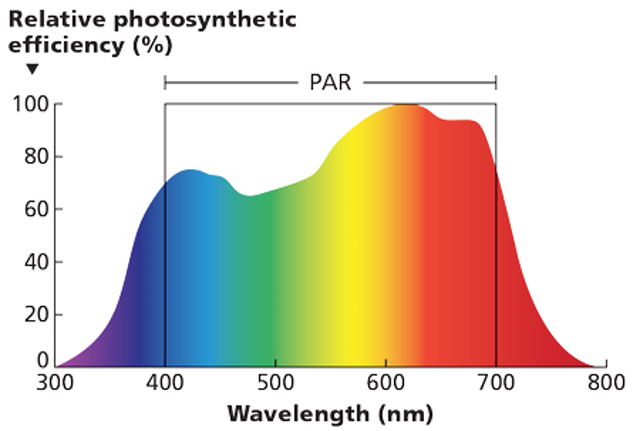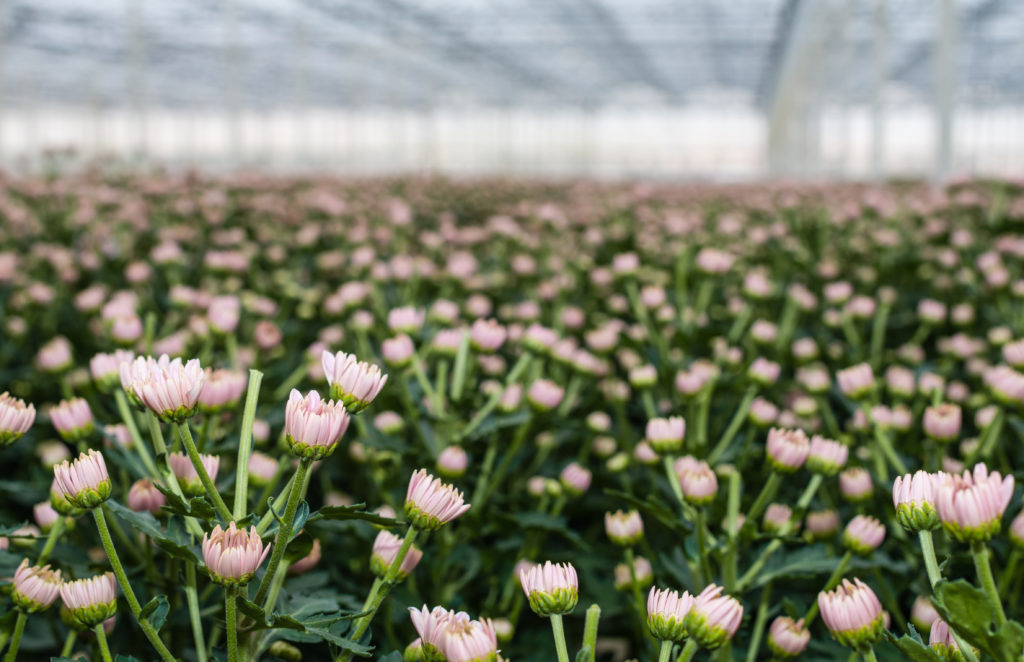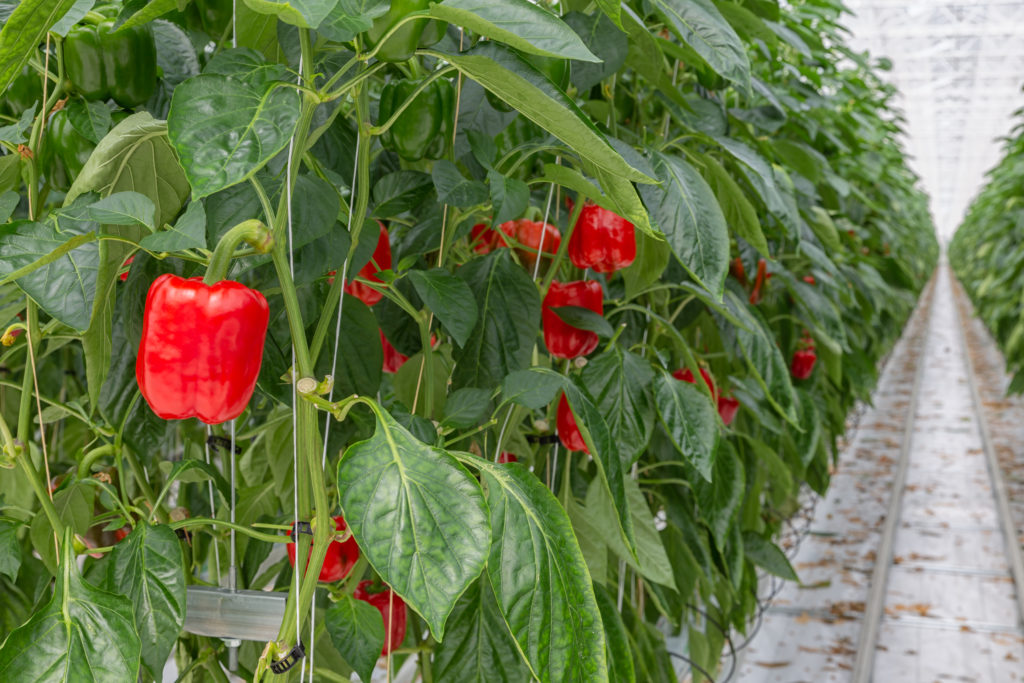Light is one of the most important factors for optimizing plant growth. Plants collect energy from light to make sugars and these sugars are used for the growth of roots, leaves, stems and flowers. Plants use light for both photosynthesis and to respond to the environment to optimize their growth. Light can be described as the visible portion of the electromagnetic spectrum which extends from about 380 to about 770 nanometers.
Plants primarily respond to wavelengths from 400-700 nanometers(nm) for photosynthesis; light within these wavelengths is referred to as photosynthetically active radiation (PAR).

The various wavelengths of light in the spectrum can trigger morphological responses. Light spectrum in terms of plant growth and morphology is often referred to as light quality, and collectively these responses to light are called Photomorphogenesis. Plants have developed sophisticated photoreceptors that enable them to respond to light quality. In this article we will outline some of these photoreceptors and their responses in relation to light quality.
Red and Far- Red Light
Light from the red (600-700nm) and far-red (700-750nm) wavelengths are responsible for enabling the photoreceptor Phytochrome. The pigment phytochrome allows plants to detect light and regulate morphological processes such as flowering, vegetative growth and set the plant’s circadian rhythm. The pigment exists in two forms – one that absorbs red light and one that absorbs far-red light. Red light causes a response in the phytochrome pigment that puts it into an active form and triggers processes such as regulating photoperiod. Since some plants require certain amount of day light hours (referred to as photoperiod) to induce flowering, by changing the light spectrum we can influence plant growth. This is typically done by using a blue-light rich light for vegetative growth and switching to a higher red-light spectrum to induce flowering.

Plants also use phytochrome to move towards light and away from shade – this is called the Shade avoidance response. Since more blue and red light is absorbed by the upper canopy compared to green and far-red, this distributes more green and far-red light to lower in the canopy. An environment high in far-red light can trigger stem extension, leaf extension, petiole elongation and apical dominance in the more shaded areas of the canopy (Lopez & Rundle, 2017). This can result in an elongated plant with increased leaf area and overall growth.
Certain seeds also require red light to initiate germination. This is usually true for smaller seeds such as snapdragons or coleus.
Blue Light
Blue light (400-500nm) is known to trigger morphological responses associated with the photoreceptors Cryptochrome and phototropin.
Blue light can act as a growth regulator, and generally suppresses growth extension, which can be advantageous for when height requirements are a factor or when plants need to be more compact in size. (In some crops though extension can be promoted). Blue light receptors may also play a role in the production of carotenoid and anthocyanin development. This can be seen in leaf colouration, such as enhancing the colour of red lettuce varieties or increased pigment and nutrition in peppers (Naznin et al., 2019).
Blue light responses in relation to phototropin include phototropism (Jones, 2018), which is the orientation of the plant in relation to light – where the plant’s growth will be directed toward where the light source is. This is often seen in indoor plants whose only light source is that of a window.
Chlorophyll accumulation, leaf expansion and positioning can also be triggered by blue light. An increase or decrease in blue light can control the opening and closing of stomata that affects photosynthesis and transpiration. Blue light is necessary, even in low intensities, for healthy plants. Plants require blue light for full functioning photosynthesis and a lack of blue light may lead to further developmental problems such as blistering on leaves and stems.

Green light
Green light (500-600nm) responses appear to be triggered under low light intensities. It has been studied that high far-red light with high green light can cause an increase in the shade avoidance response (Wang & Falta, 2013). While far-red light is not useful for photosynthesis, green light is. And one potential advantage to green light is since it can penetrate the lower canopy better the lower leaves can continue to photosynthesize. This is because red and blue light is more readily absorbed higher in the canopy and green penetrates further down. Adding green light to a spectrum also makes the work environment more pleasant for employees, as the combination of red, blue and green light creates white light, which means workers can be more effective at monitoring for pests, disease and other issues.
UV Light
While UV (280-400nm) does not play a role in the growth of a plant it may have a role in the activation of a plants’ defense mechanism. Although damaging in large quantities, UV light can have important benefits such as producing different defense proteins that give them protection against pests and disease. Plants are also able to increase antioxidant compounds to protect themselves against UV light damage, and many of these also add to the nutritional value of the plant. Researchers have found that UV-B wavelengths in the 280-315nm range can also play a role in the development of flavonoids and phenolic acids (Escobar-Bravo et al., 2019).

Conclusion
So, what does all this mean for your growing needs? Depending on what type of crop you are growing and desired goal, light spectrum can play a significant role in shaping your plants’ development. It should be noted though, that different plant species and varieties will respond differently to light quality and the percentages of various light wavelengths. More research is needed to effectively use these wavelengths/spectrums to create light recipes for enhanced plant development. For example, Naznin, et al., (2019), found that carotenoid accumulation, triggered by blue light, increases in lettuce and pepper under a 91% red and 9% blue treatment, but was different for kale and basil where carotenoid accumulation was higher under 83% red light and 17% blue light. This demonstrates that to reach your desired goal when growing using customized light spectrums, you must take each individual plant into account.
References:
Escobar-Bravo, R., G. Chen, H.K. Kim, K. Grosser, N. Van Dam, K.A. Leiss, & P.G.L. Klinkhamer. Ultraviolet radiation exposure time and intensity modulate tomato resistance to herbivory through activation of jasmonic acid signaling. 2019. Journal of experimental botany 70:1: 315-327.
Jones, M.A. 2018. Using light to improve commercial value. Horticultural Research 5:47.
Lopez, R & E. Rundle. 2017. Light Management in Controlled Environments. Meister Media Worldwide. Ohio, USA.
Naznin, T., M. Lefsrud, V. Gravel & M.O.K. Azad. 2019. Blue light added with Red LEDs Enhance growth characteristics, pigment content and antioxidant capacity in lettuce, spinach, kale, basil and sweet pepper in a controlled environment. Plant 8:93.
Wang, Y., & K. Folta 2013. Contributions of green light to plant growth and development. American Journal of Botany 100: 70-76.
To learn more on the photoreceptor phytochrome and red and far-red light watch this informative video. https://www.youtube.com/watch?v=tf3avaZCCQo

Jill Whitehead is a digital marketing specialist with P.L. Light Systems and brings over 10 years of experience in the agricultural industry. Prior to joining P.L. Light Systems Jill worked as a grower running her own farm business.


